Effect of Smart Aggregate Size on Mesostructure and Mechanical Properties of Asphalt Mixtures
Abstract
:1. Introduction
2. Materials and Methods
2.1. Asphalt and Asphalt Mixture
2.1.1. Conventional Properties of Asphalt Binders
2.1.2. Gradation and Basic Properties of Asphalt Mixtures
2.1.3. Dynamic Modulus Test of Asphalt Mixtures
2.2. Establishment of Discrete Element Model for Asphalt Mixture
2.2.1. Establishment and Placement of Coarse and Smart Aggregates
2.2.2. Placement of Asphalt Mortar
- (1)
- Replacing the mortar with equal volumes of equal-diameter ball particles increases the overall volume of the mortar.
- (2)
- Using a diameter reduction factor (DRF) minimizes the overall volume-increasing effect of replacing the asphalt mortar with ball particles.
- (3)
- Considering the multiple volumetric indicators and contact characteristics of the mix, including particle overlap ratio, number of ball–wall contacts, and average wall stress, the DRF is recommended to be in the range of 0.8 to 0.86 in terms of both computational efficiency and accuracy.
2.2.3. Conversion of Macro-Micro Parameters in Discrete Element Models
2.2.4. Compaction of Discrete Element Specimens of Asphalt Mixtures
2.3. Void Distribution Contour Map of the Asphalt Mixtures
2.3.1. Void Distribution Contour Map in the Longitudinal Section
2.3.2. Void Distribution Contour Map in the Transverse Section
3. Results and Discussion
3.1. Verification of Discrete Element Model for Asphalt Mixture
3.2. Effect of Smart Aggregate Size on the Mesostructure of Asphalt Mixtures
- (1)
- With the increase in smart aggregate size, the mean void ratio in the longitudinal sections of asphalt mixture specimens embedded with three different sizes of smart aggregates are 37.86%, 30.59%, and 28.86%, respectively. Compared to the specimen without embedded smart aggregates, the variations are −5.25%, −23.45%, and −27.78%, respectively. The minimum values are 13.39%, 2.81%, and 2.16%, while the maximum values are 81.35%, 88.54%, and 89.63%, with standard deviations of 16.68, 19.78, and 22.86, respectively. These results indicate that as the size of the smart aggregates increases, the mean void ratio in the contour map decreases. It is inferred that the presence of smart aggregates within the selected section reduces the overall void ratio. However, the difference between the minimum and maximum void ratios increases, suggesting that the non-uniformity of the void distribution also increases.
- (2)
- With the increase in smart aggregate size, the mean void ratios in the transverse sections of asphalt mixture specimens embedded with three different sizes of smart aggregates are 38.90%, 29.01%, and 24.23%, respectively. Compared to the specimen without embedded smart aggregates, these values decreased by 12.24%, 34.57%, and 45.33%, respectively. The minimum values are 13.41%, 4.78%, and 2.83%, while the maximum values are 81.35%, 88.54%, and 89.63%, with standard deviations of 19.76, 20.46, and 27.11, respectively. The distribution results of the void ratio contour maps in the transverse sections show a trend similar to that observed in the longitudinal sections, with an even greater impact on the non-uniformity in the transverse sections.
3.3. Effect of Smart Aggregate Size on the Mechanical Properties of Asphalt Mixtures
3.3.1. Effect of Smart Aggregate Size on the Dynamic Modulus of Asphalt Mixtures
3.3.2. Internal Strain Rate of Asphalt Mixtures
4. Conclusions
- As the size of the smart aggregate increases, the average void ratio in the longitudinal section of the asphalt mixture decreases by 5.25%, 23.45%, and 27.78%, as compared to that of the specimen without embedded smart aggregate. With the increase in the smart aggregate, the average void ratio in the transverse section decreased by 12.24%, 34.57%, and 45.33%. Overall, the average void ratio of asphalt mixture decreases with increasing smart aggregate size, but the inhomogeneity of void distribution increases, and the void structure in the transverse section is more affected by the smart aggregates.
- At 25 °C, 25 Hz, the dynamic modulus of the asphalt mixtures decreased by 5.53%, 10.75%, and 13.72%, compared to the specimens without embedded smart aggregates. At 0.1 Hz, the dynamic modulus of the asphalt mixture decreased by 1.71%, 8.76%, and 9.81%, compared to the specimens without embedded smart aggregate. Overall, this reduction effect increased with the increase in the size of smart aggregates and also with the increase in the loading frequency.
- The lack of asphalt coating on the surface of the smart aggregate influenced the internal strain of the asphalt mixture. Under the peak load of a semi-sine wave, the strain rate in the z-axis direction of the asphalt mixture decreased compared to the specimen without embedded smart aggregate, indicating that the smart aggregates partially inhibit the downward deformation of the specimen. However, the strain rate of the asphalt mixture increases in the x, y cross section. As the size of the smart aggregates increases, these effects become more pronounced. Overall, the increase in transverse strain is the primary reason for the decrease in the overall dynamic modulus of the asphalt mixture specimens.
Supplementary Materials
Author Contributions
Funding
Institutional Review Board Statement
Informed Consent Statement
Data Availability Statement
Conflicts of Interest
References
- Mollenhauer, K.; Wistuba, M.P. Influence of asphalt compaction procedure on 3D deformation properties. Int. J. Pavement Eng. 2016, 17, 5–12. [Google Scholar] [CrossRef]
- You, Z.; Dai, Q. Review of advances in micromechanical modeling of aggregate–aggregate interactions in asphalt mixtures. Can. J. Civ. Eng. 2007, 34, 239–252. [Google Scholar] [CrossRef]
- Birgin, H.B.; D’Alessandro, A.; Corradini, A.; Laflamme, S.; Ubertini, F. Self-sensing asphalt composite with carbon microfibers for smart weigh-in-motion. Mater. Struct. 2022, 55, 138. [Google Scholar] [CrossRef]
- Palese, M.; Zarembski, A.M.; Huang, H.; Palese, J. Ballast particle dynamic response as a function of subgrade support using statistical methods. Constr. Build. Mater. 2022, 325, 126772. [Google Scholar] [CrossRef]
- Wang, X.; Huang, H.; Tutumluer, E.; Tingle, J.S.; Shen, S. Monitoring Particle Movement under Compaction using SmartRock Sensor: A Case Study of Granular Base Layer Compaction. Transp. Geotech. 2022, 34, 100764. [Google Scholar] [CrossRef]
- Gu, Q.; Zhao, C.; Bian, X.; Morrissey, J.P.; Ooi, J.Y. Trackbed settlement and associated ballast degradation due to repeated train moving loads. Soil Dyn. Earthq. Eng. 2022, 153, 107109. [Google Scholar] [CrossRef]
- Liu, S.; Huang, H.; Qiu, T.; Kwon, J. Effect of geogrid on railroad ballast particle movement. Transp. Geotech. 2016, 9, 110–122. [Google Scholar] [CrossRef]
- Liu, S.; Huang, H.; Qiu, T.; Gao, L. Comparison of Laboratory Testing Using SmartRock and Discrete Element Modeling of Ballast Particle Movement. J. Mater. Civ. Eng. 2017, 29, D6016001. [Google Scholar] [CrossRef]
- Liu, S.; Huang, H.; Qiu, T.; Kerchof, B. Characterization of Ballast Particle Movement at Mud Spot. J. Mater. Civ. Eng. 2019, 31, 04018339. [Google Scholar] [CrossRef]
- Feng, B.; Basarah, Y.I.; Gu, Q.; Duan, X.; Bian, X.; Tutumluer, E.; Hashash, Y.M.A.; Huang, H. Advanced full-scale laboratory dynamic load testing of a ballasted high-speed railway track. Transp. Geotech. 2021, 29, 100559. [Google Scholar] [CrossRef]
- Gu, Q.; Liu, H.; Wu, Y.; Luo, Z.; Bian, X. Evolution of trackbed performance and ballast degradation due to passages of million train wheel axle loads. Transp. Geotech. 2022, 34, 100753. [Google Scholar] [CrossRef]
- Dai, J.; Ma, F.; Fu, Z.; Li, C.; Jia, M.; Shi, K.; Wen, Y.; Wang, W. Applicability assessment of stearic acid/palmitic acid binary eutectic phase change material in cooling pavement. Renew. Energy 2021, 175, 748–759. [Google Scholar] [CrossRef]
- Liu, J.; Zhang, T.; Guo, H.; Wang, Z.; Wang, X. Evaluation of self-healing properties of asphalt mixture containing steel slag under microwave heating: Mechanical, thermal transfer and voids microstructural characteristics. J. Clean. Prod. 2022, 342, 130932. [Google Scholar] [CrossRef]
- Wang, X.; Shen, S.; Huang, H.; Zhang, Z. Towards smart compaction: Particle movement characteristics from laboratory to the field. Constr. Build. Mater. 2019, 218, 323–332. [Google Scholar] [CrossRef]
- Wang, X.; Shen, S.; Huang, H. Meso-Scale Kinematic Responses of Asphalt Mixture in Both Field and Laboratory Compaction. Transp. Res. Rec. 2021, 2675, 1631–1642. [Google Scholar] [CrossRef]
- Dan, H.-C.; Yang, D.; Zhao, L.-H.; Wang, S.-P.; Zhang, Z. Meso-scale study on compaction characteristics of asphalt mixtures in Superpave gyratory compaction using SmartRock sensors. Constr. Build. Mater. 2020, 262, 120874. [Google Scholar] [CrossRef]
- Cheng, Z.; Zhang, D.; Xie, S.; Polaczyk, P.A.; Wang, T. SmartRock-Based Research on Gyratory Locking Point for Stone Mastic Asphalt Mixture. Buildings 2022, 12, 97. [Google Scholar] [CrossRef]
- Shan, H.-Y.; Dan, H.-C.; Wang, S.-P.; Liu, X.; Wang, H. Theoretical and Experimental Investigation on Dynamic Response of Asphalt Pavement Under Vibration Compaction. Front. Mater. 2022, 8, 816949. [Google Scholar] [CrossRef]
- Wang, N.; Chen, F.; Ma, T.; Luan, Y.; Zhu, J. Compaction performance of cold recycled asphalt mixture using SmartRock sensor. Autom. Constr. 2022, 140, 104377. [Google Scholar] [CrossRef]
- Jiang, W.; Wang, T.; Yuan, D.; Sha, A.; Zhang, S.; Zhang, Y.; Xiao, J.; Xing, C. Available solar resources and photovoltaic system planning strategy for highway. Renew. Sustain. Energy Rev. 2024, 203, 114765. [Google Scholar] [CrossRef]
- Zhang, C.; Shen, S.; Huang, H.; Wang, L. Estimation of the Vehicle Speed Using Cross-Correlation Algorithms and MEMS Wireless Sensors. Sensors 2021, 21, 1721. [Google Scholar] [CrossRef] [PubMed]
- Shi, B.; Shen, S.; Liu, L.; Wang, X. Estimation of Vehicle Speed from Pavement Stress Responses Using Wireless Sensors. J. Transp. Eng. Part B. Pavements 2021, 147, 04021028. [Google Scholar] [CrossRef]
- Zhang, K.; Luo, Y.; Xie, W.; Wu, J. Evaluation of road performance and adhesive characteristic of asphalt binder in salt erosion environment. Mater. Today Commun. 2020, 25, 101593. [Google Scholar] [CrossRef]
- Zhang, W.; Zhang, Z.; Zhao, Q. Laboratory Performance Evaluation of a Waterborne Epoxy-Modified Asphalt Mixture with Styrene-Butadiene Rubber for Cold Patching Applications. J. Mater. Civ. Eng. 2022, 34, 04022111. [Google Scholar] [CrossRef]
- Shan, J.; Jiang, W.; Huang, Y.; Yuan, D.; Liu, Y. Unmanned Aerial Vehicle (UAV)-Based Pavement Image Stitching without Occlusion, Crack Semantic Segmentation, and Quantification. IEEE Trans. Intell. Transp. Syst. 2024, 1–16. [Google Scholar] [CrossRef]
- Dan, H.-C.; Yang, D.; Liu, X.; Peng, A.-P.; Zhang, Z. Experimental investigation on dynamic response of asphalt pavement using SmartRock sensor under vibrating compaction loading. Constr. Build. Mater. 2020, 247, 118592. [Google Scholar] [CrossRef]
- Li, Y. Research on the Influencing Mechanism of Compaction of Asphalt Mixture and Changes in Internal Meso Structure and Mechanical Response. Ph.D. Thesis, Chang’an University, Xi’an, China, 2024. [Google Scholar]
- ASTM D5/D5M; Test Method for Penetration of Bituminous Materials. ASTM International: West Conshohocken, PA, USA, 2019.
- ASTM D36/D36M; Test Method for Softening Point of Bitumen (Ring-and-Ball Apparatus). ASTM International: West Conshohocken, PA, USA, 2014.
- ASTM D113; Test Method for Ductility of Bituminous Materials. ASTM International: West Conshohocken, PA, USA, 2017.
- ASTM D2171; Test Method for Viscosity of Asphalts by Vacuum Capillary Viscometer. ASTM International: West Conshohocken, PA, USA, 2018.
- ASTM D92; Test Method for Flash and Fire Points by Cleveland Open Cup Tester. ASTM International: West Conshohocken, PA, USA, 2005.
- ASTM D2042; Test Method for Solubility of Asphalt Materials in Trichloroethylene or Toluene. ASTM International: West Conshohocken, PA, USA, 2022.
- ASTM D70; Test Method for Density of Semi-Solid Bituminous Materials (Pycnometer Method). ASTM International: West Conshohocken, PA, USA, 2009.
- ASTM D2172; Test Methods for Quantitative Extraction of Asphalt Binder from Asphalt Mixtures. ASTM International: West Conshohocken, PA, USA, 2017.
- JTG F40-2004; Technical Specification for Construction of Highway Asphalt Pavements. Research Institute of Highway Ministry of Transport: Beijing, China, 2004.
- AASHTO T312; Method of Test for Preparing and Determining the Density of Asphalt Mixture Specimens by Means of the Superpave Gyratory Compactor. American Association of State Highway Transportation Officials: Washington, DC, USA, 2022.
- AASHTO PP 99; Practice for Preparation of Small Cylindrical Performance Test Specimens Using the Superpave Gyratory Compactor (SGC) or Field Cores. American Association of State Highway Transportation Officials: Washington, DC, USA, 2019.
- AASHTO TP 132; Method of Test for Determining the Dynamic Modulus for Asphalt Mixtures Using Small Specimens in the Asphalt Mixture Performance Tester (AMPT). American Association of State Highway Transportation Officials: Washington, DC, USA, 2019.
- Guo, Q.; Xu, H.; Wang, J.; Hang, J.; Wang, K.; Hu, P.; Li, H. Gradation Optimization Based on Micro-Analysis of Rutting Behavior of Asphalt Mixture. Coatings 2023, 13, 1965. [Google Scholar] [CrossRef]
- Yao, Y.; Li, J.; Liang, C.; Hu, X. Effect of Coarse Recycled Aggregate on Failure Strength for Asphalt Mixture Using Experimental and DEM Method. Coatings 2021, 11, 1234. [Google Scholar] [CrossRef]
- Li, X.; Gao, J.; Du, H.; Jia, J.; Zhao, X.; Ling, T. Relationship between the Void and Sound Absorption Characteristics of Epoxy Porous Asphalt Mixture Based on CT. Coatings 2022, 12, 328. [Google Scholar] [CrossRef]
- Cundall, P.A.; Strack, O.D.L. A discrete numerical model for granular assemblies. Géotechnique 1979, 29, 47–65. [Google Scholar] [CrossRef]
- Zhou, X.; Chen, S.; Ge, D.; Jin, D.; You, Z. Investigation of asphalt mixture internal structure consistency in accelerated discrete element models. Constr. Build. Mater. 2020, 244, 118272. [Google Scholar] [CrossRef]
- Chen, J.; Huang, B.; Chen, F.; Shu, X. Application of discrete element method to Superpave gyratory compaction. Road Mater. Pavement Des. 2012, 13, 480–500. [Google Scholar] [CrossRef]
- Yi, X.; Chen, H.; Wang, H.; Tang, Z.; Yang, J.; Wang, H. Cross-Functional Test to Explore the Determination Method of Meso-Parameters in the Discrete Element Model of Asphalt Mixtures. Materials 2021, 14, 5786. [Google Scholar] [CrossRef] [PubMed]
- Torquato, S.; Truskett, T.M.; Debenedetti, P.G. Is Random Close Packing of Spheres Well Defined? Phys. Rev. Lett. 2000, 84, 2064–2067. [Google Scholar] [CrossRef]
- Zaccone, A. Explicit Analytical Solution for Random Close Packing in d = 2 and d = 3. Phys. Rev. Lett. 2022, 128, 028002. [Google Scholar] [CrossRef] [PubMed]
- Finney, J.L. Random packings and the structure of simple liquids. I. The geometry of random close packing. Proc. R. Soc. London, Ser. A Math. Phys. Sci. 1970, 319, 479–493. [Google Scholar] [CrossRef]
- Kamien, R.D.; Liu, A.J. Why is Random Close Packing Reproducible? Phys. Rev. Lett. 2007, 99, 155501. [Google Scholar] [CrossRef]
- Karayiannis, N.C.; Laso, M. Dense and Nearly Jammed Random Packings of Freely Jointed Chains of Tangent Hard Spheres. Phys. Rev. Lett. 2008, 100, 050602. [Google Scholar] [CrossRef]
- Wilken, S.; Guerra, R.E.; Levine, D.; Chaikin, P.M. Random Close Packing as a Dynamical Phase Transition. Phys. Rev. Lett. 2021, 127, 038002. [Google Scholar] [CrossRef]
- Liu, Y.; Su, P.; Li, M.; Yao, H.; Liu, J.; Xu, M.; Zhou, X.; You, Z. How to Achieve Efficiency and Accuracy in Discrete Element Simulation of Asphalt Mixture: A DRF-Based Equivalent Model for Asphalt Sand Mortar. Adv. Civ. Eng. 2020, 2020, 8855409. [Google Scholar] [CrossRef]
- Roozbahany, E.G.; Partl, M.N. Investigation of asphalt joint compaction using discrete element simulation. Road Mater. Pavement Des. 2019, 20, 1722–1734. [Google Scholar] [CrossRef]
- Liu, Y.; Dai, Q.; You, Z. Viscoelastic Model for Discrete Element Simulation of Asphalt Mixtures. J. Eng. Mech. 2009, 135, 324–333. [Google Scholar] [CrossRef]
- Cai, W.; McDowell, G.R.; Airey, G.D. Discrete element visco-elastic modelling of a realistic graded asphalt mixture. Soils Found. 2014, 54, 12–22. [Google Scholar] [CrossRef]

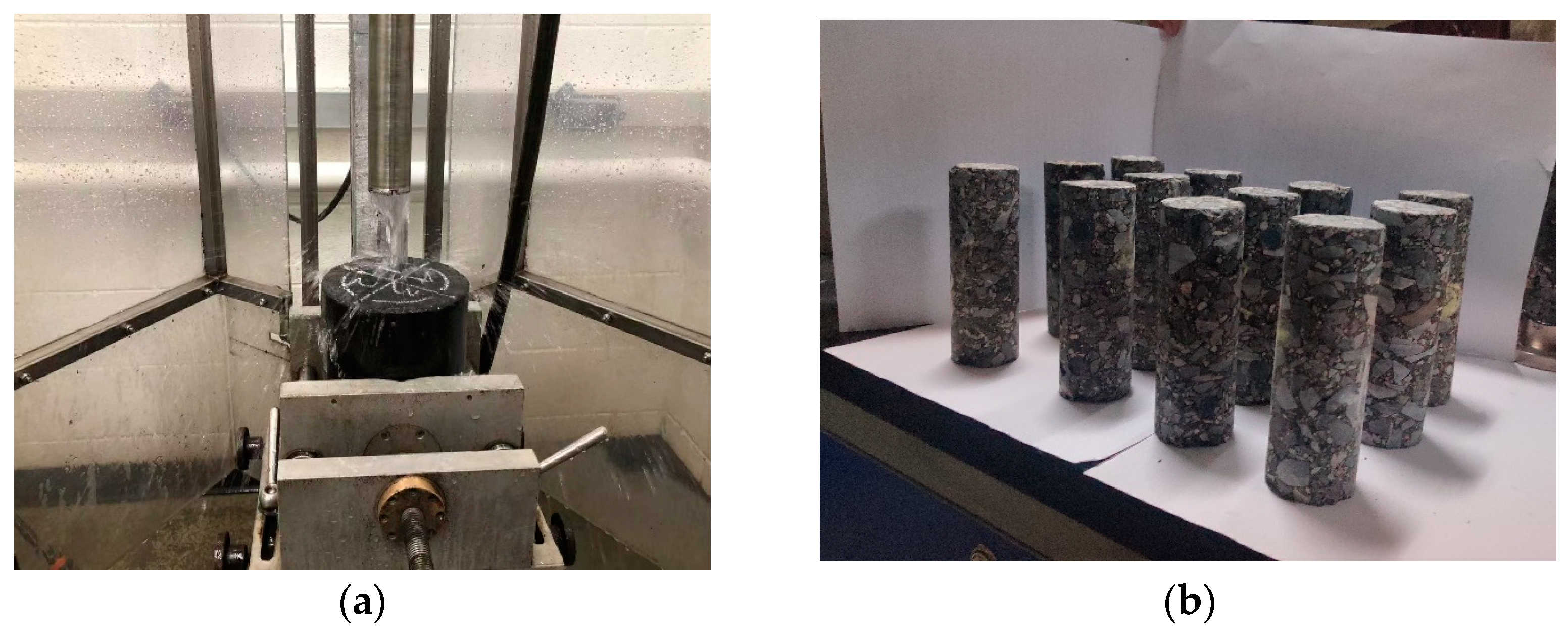
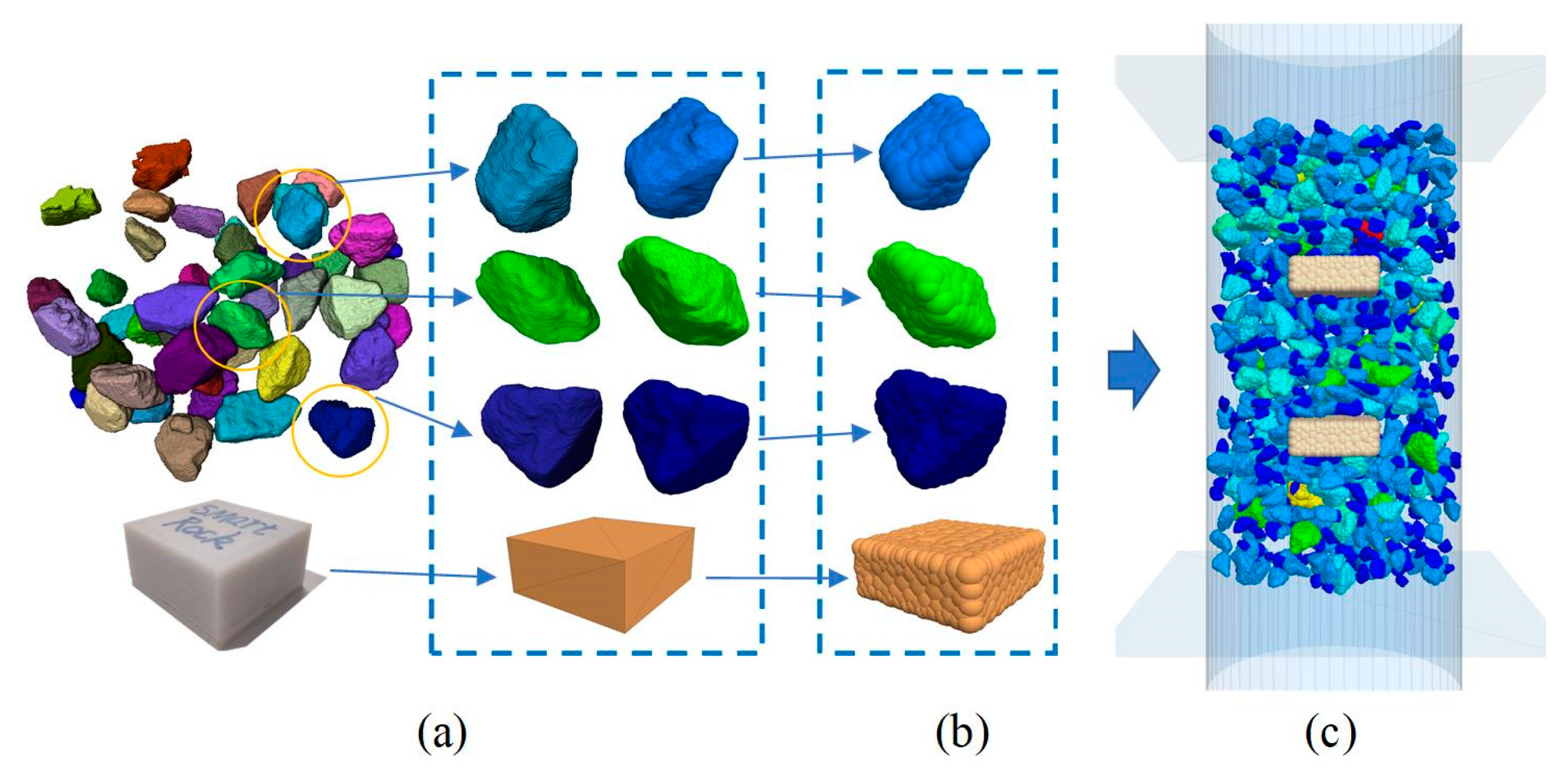
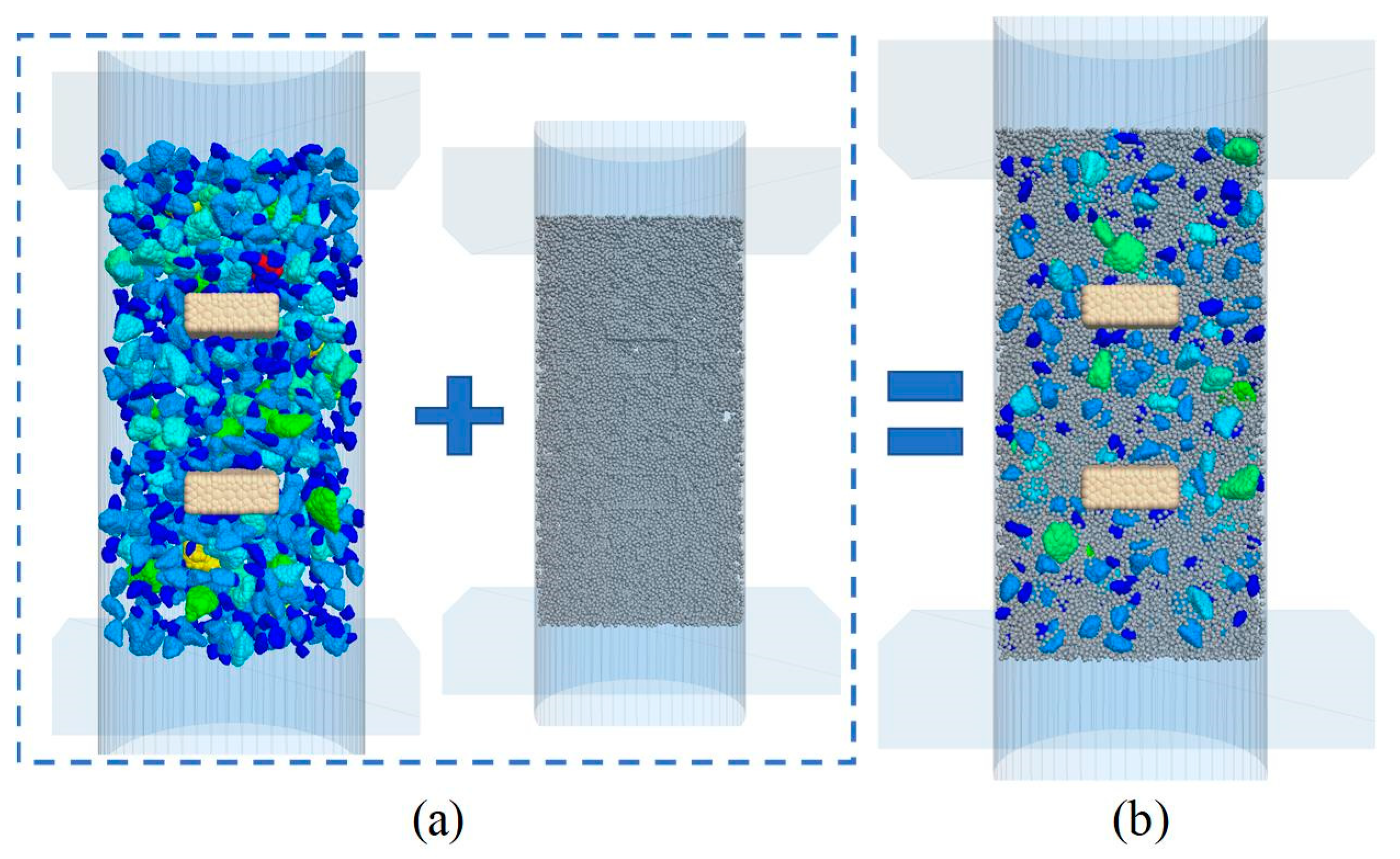
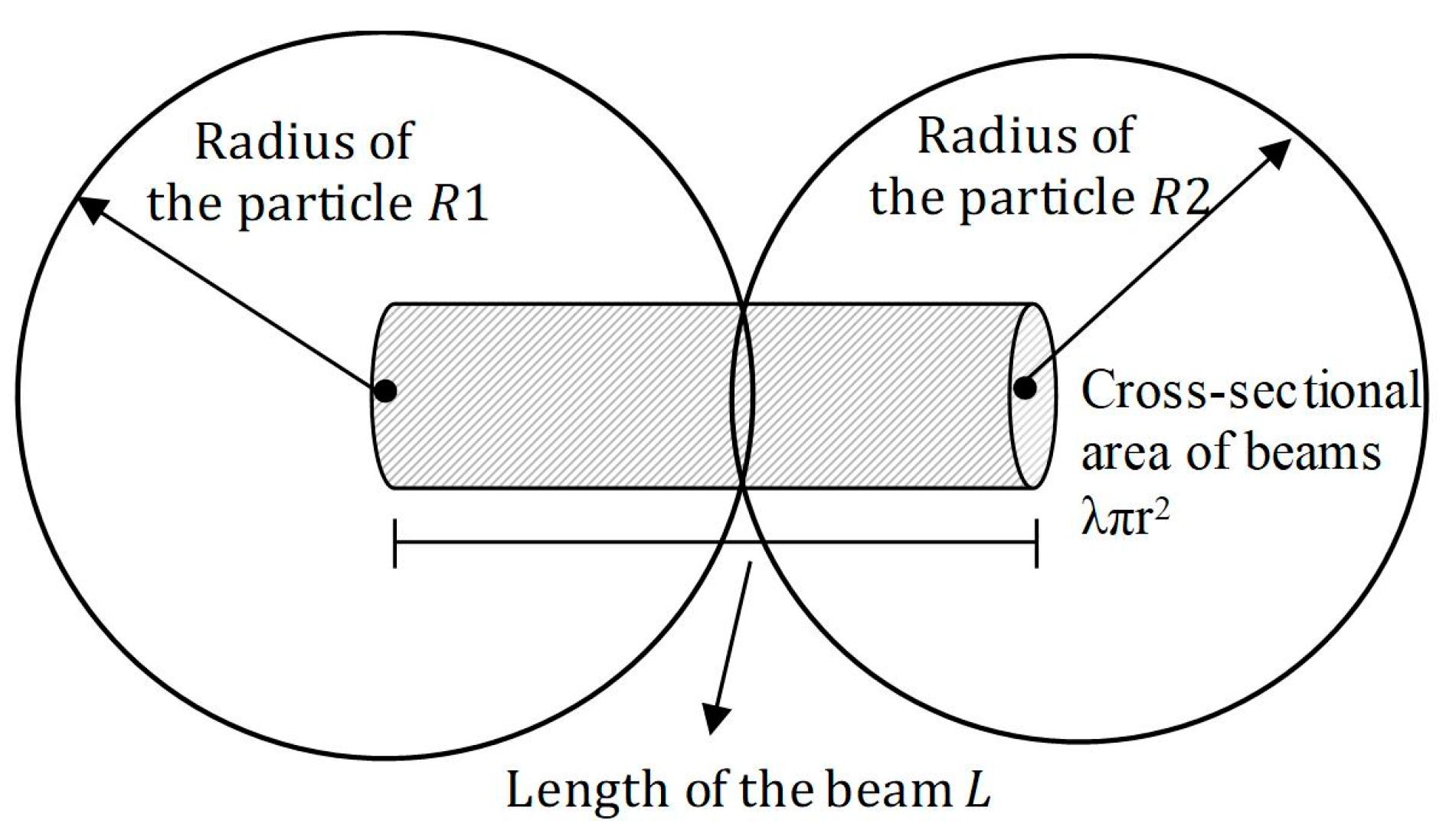
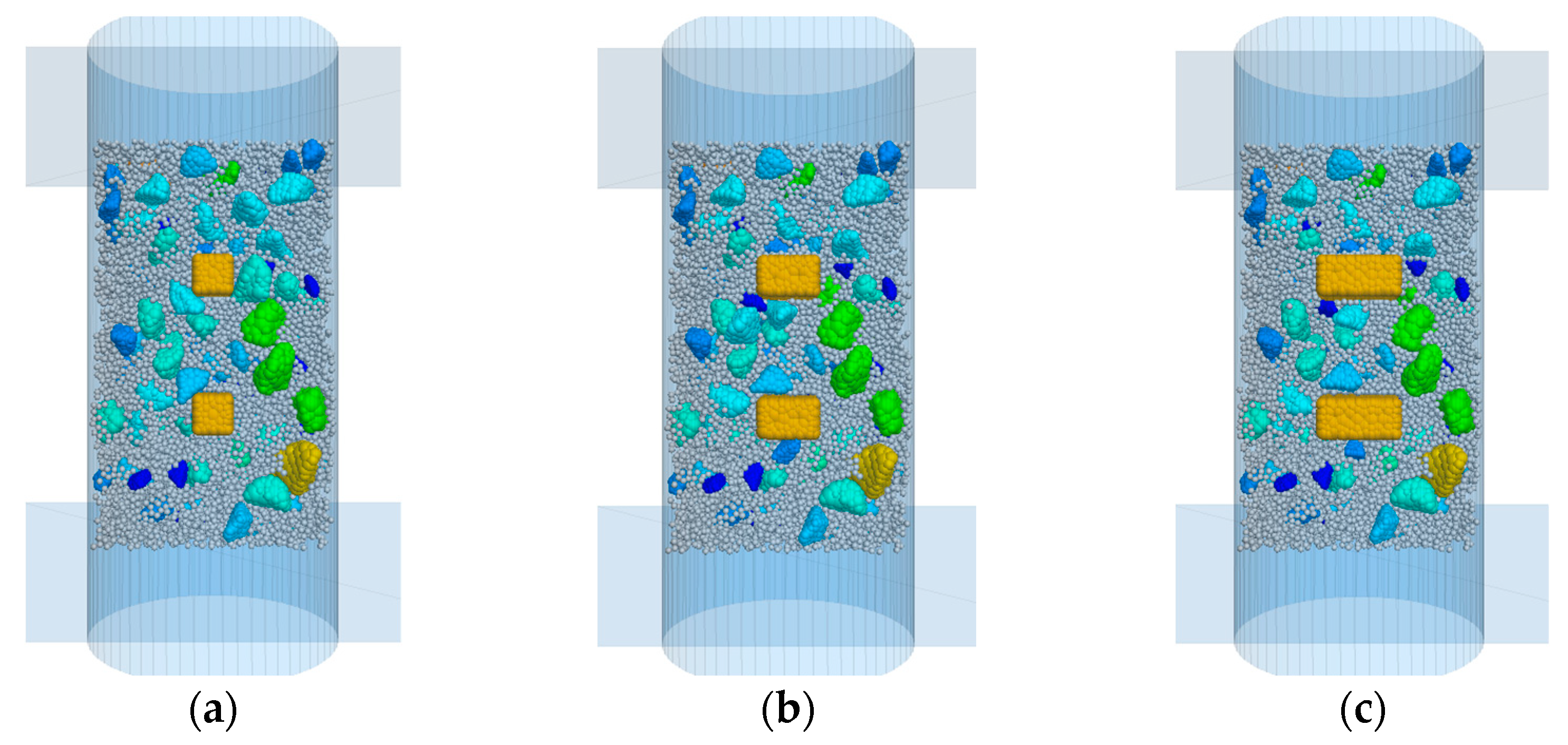
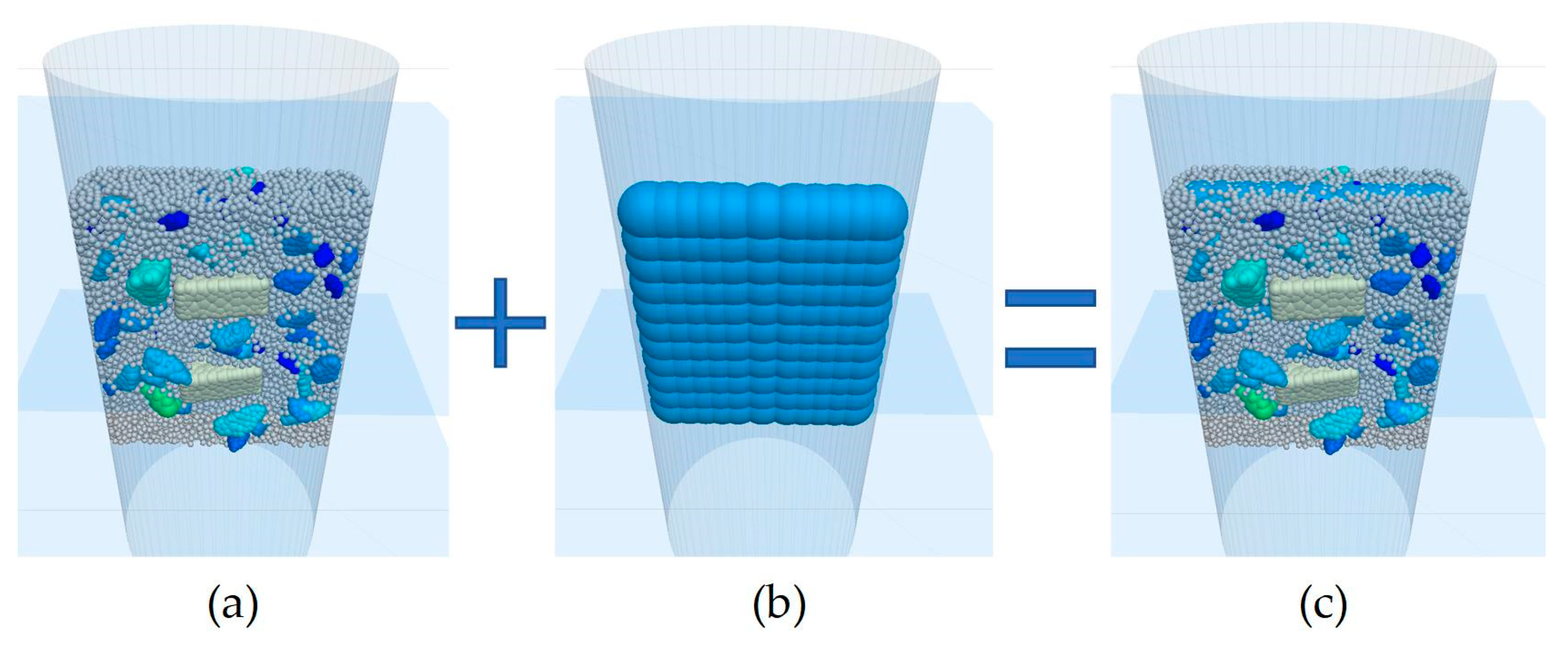
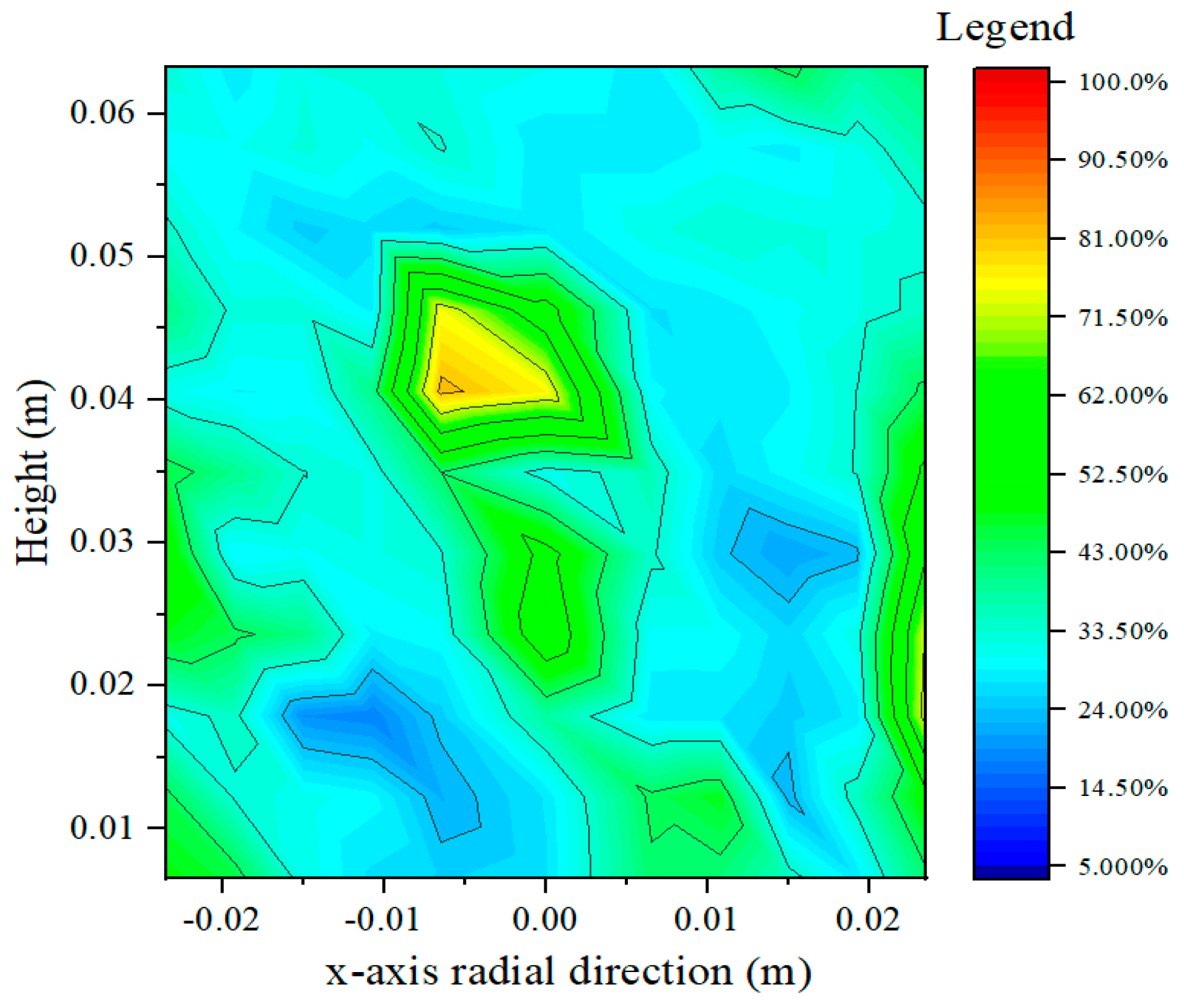
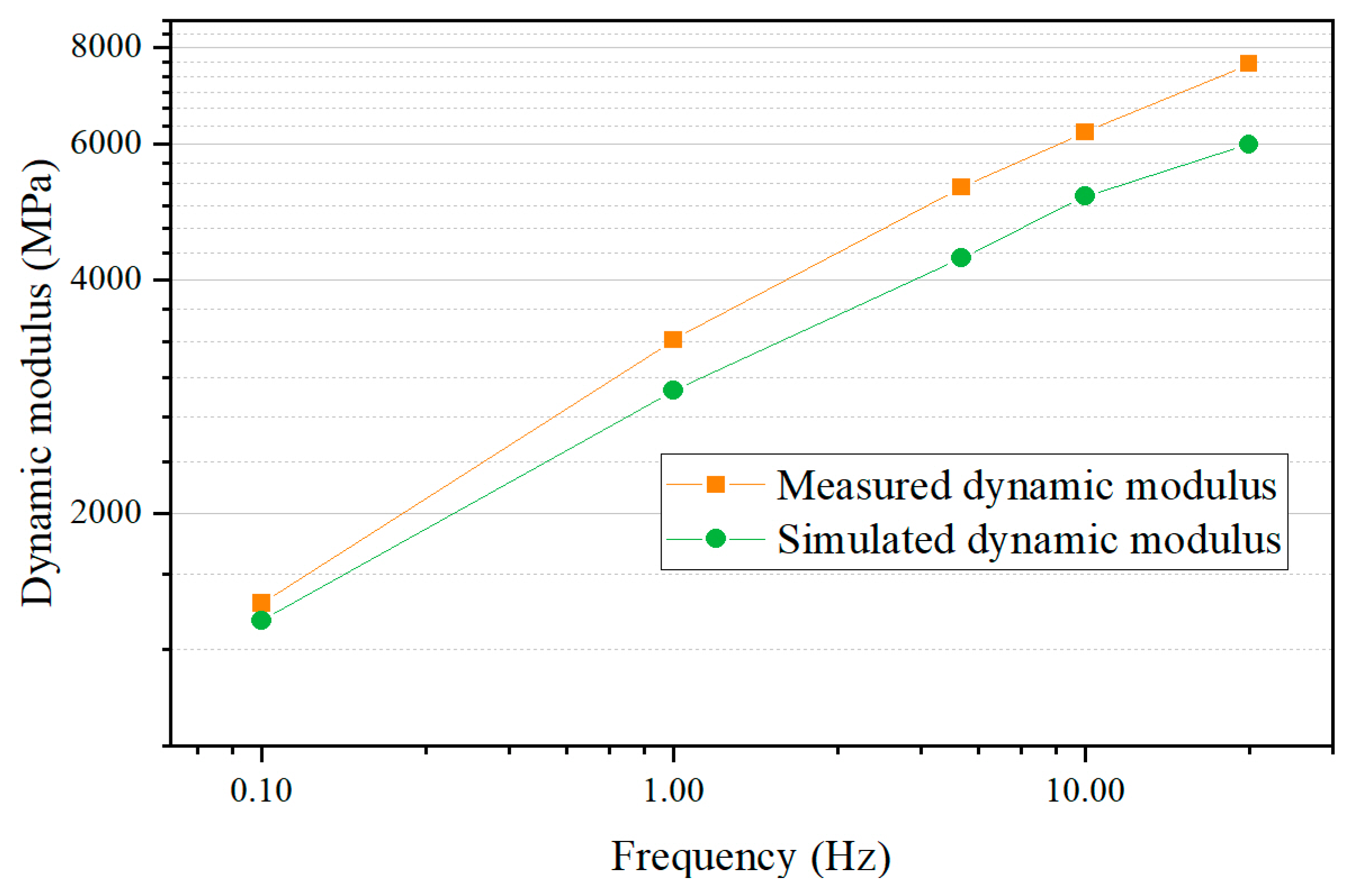
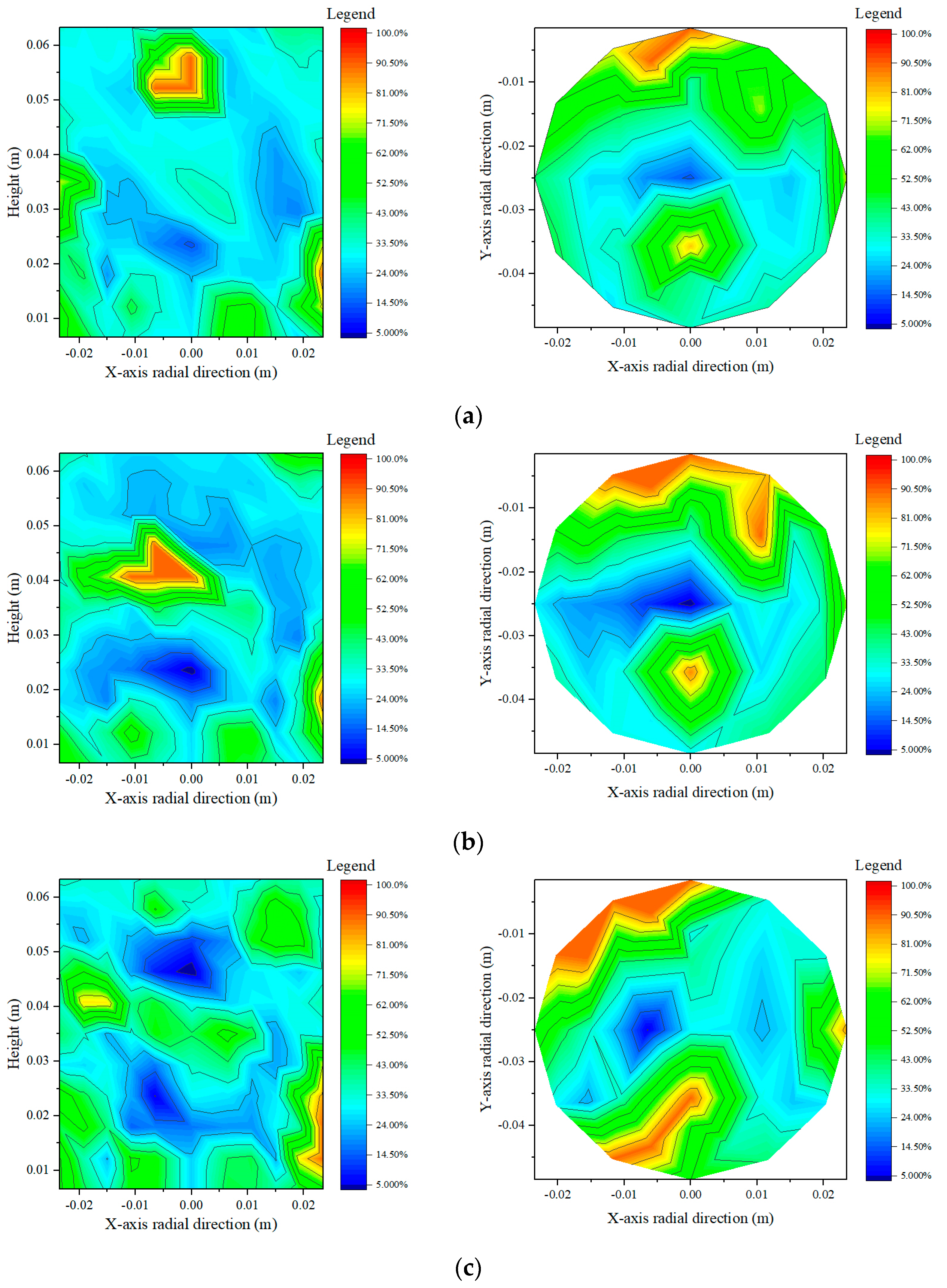

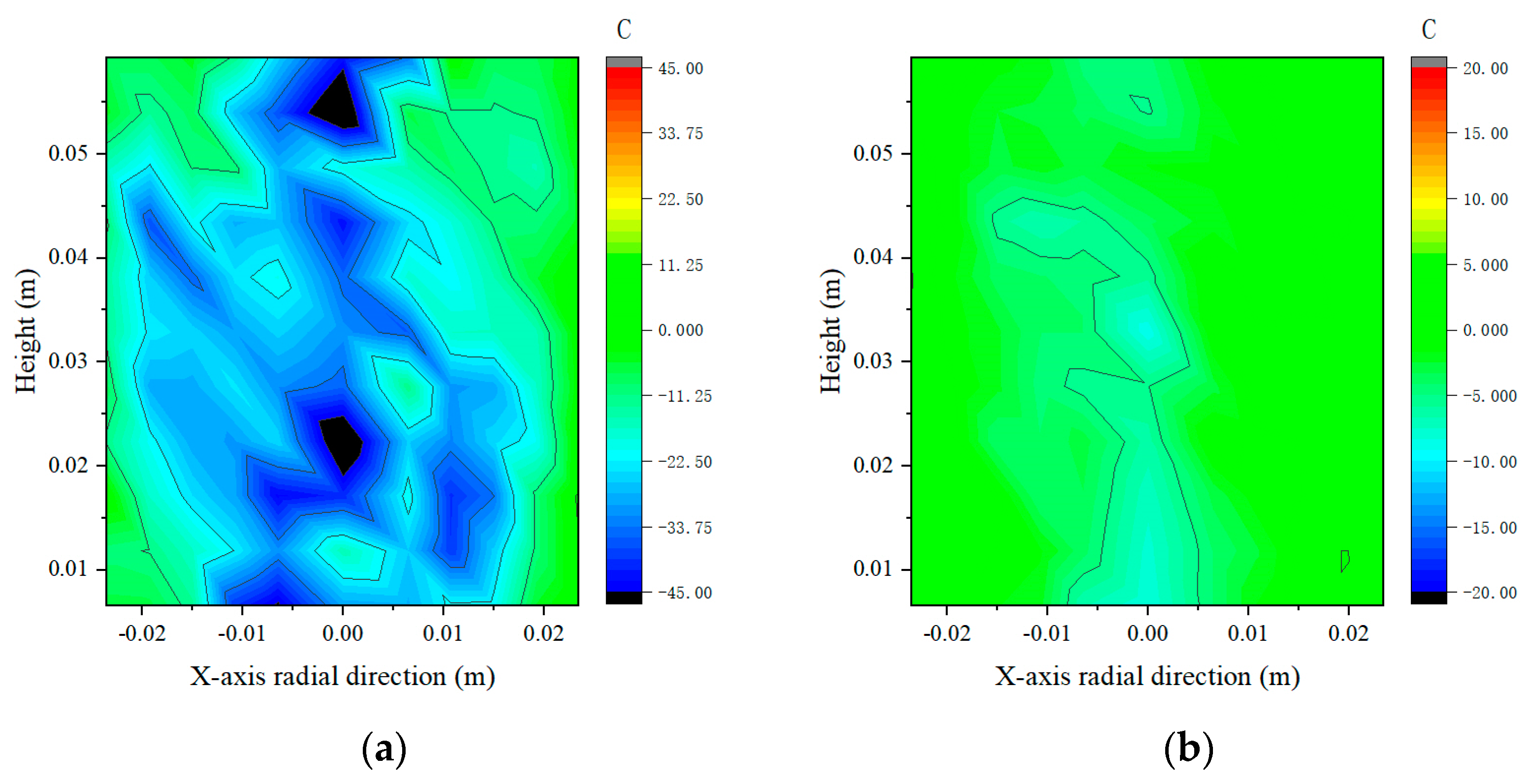


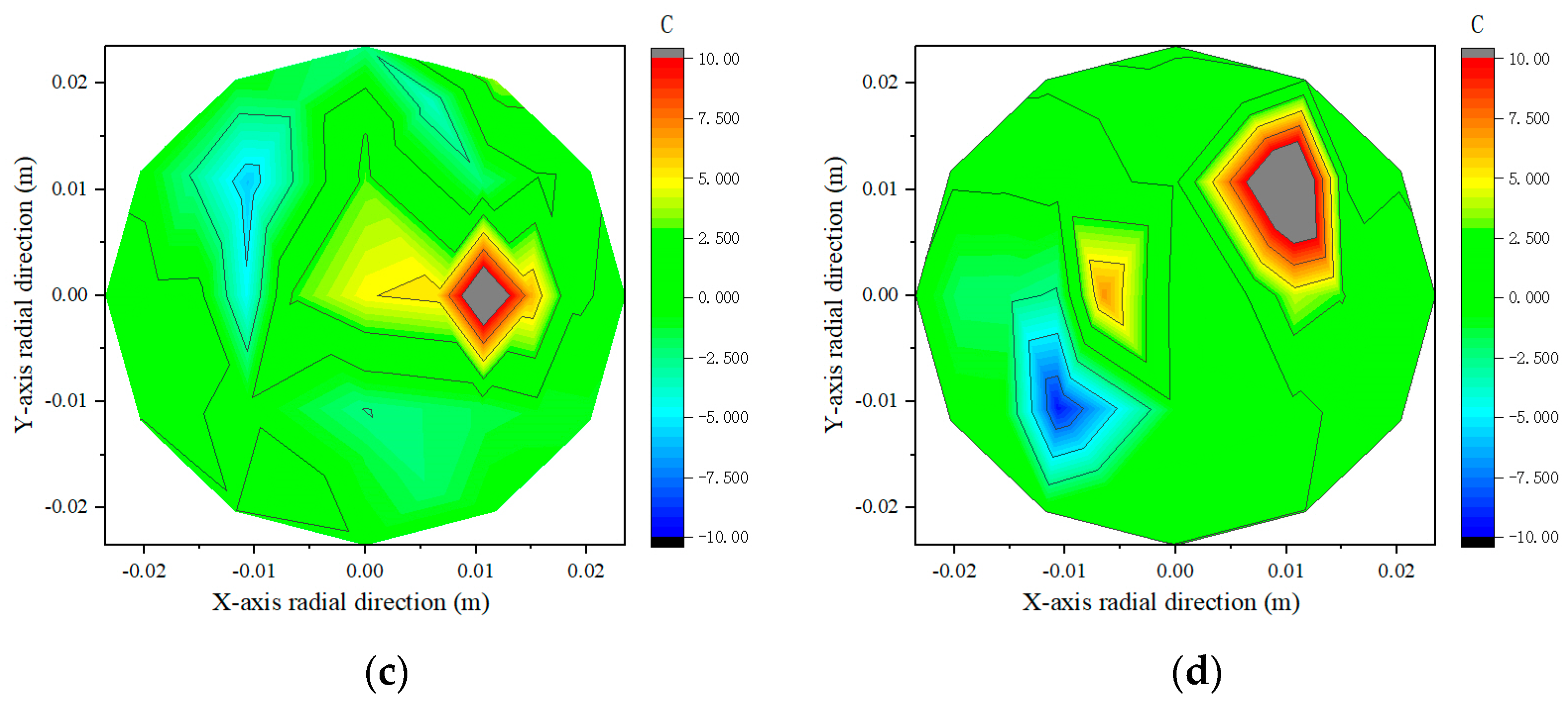
| Test parameters | Results | Testing methods |
|---|---|---|
| Penetration (25 °C, 100 g, 5 s, 0.1 mm) | 68.1 | ASTM D5/D5M [28] |
| Softening point (°C) | 49.8 | ASTM D36/36M [29] |
| Ductility (5 cm/min, 15 °C, cm) | >100 | ASTM D113 [30] |
| Ductility (5 cm/min, 10 °C, cm) | 53 | ASTM D113 [30] |
| 60 °C dynamic viscosity (Pa·s) | 195 | ASTM D2171 [31] |
| Flashpoint (°C) | 295 | ASTM D92 [32] |
| Solubility (trichloroethylene, %) | 99.5 | ASTM D2042 [33] |
| Density (g/cm3) | 1.031 | ASTM D70 [34] |
| Test Items | Bulk Density (g/cm3) | Air Voids (%) | Water Absorption (%) | Marshall Stability (kN) | Flow Value (mm) |
|---|---|---|---|---|---|
| Results | 2.465 | 4.6 | 0.81 | 10.95 | 4.45 |
| Viscoelastic Parameters | E1 (GPa) | η1 (MPa·s) | E2 (MPa) | η2 (MPa·s) |
|---|---|---|---|---|
| Results | 21.830 ± 0.32 | 0.544 ± 0.08 | 5.555 ± 0.12 | 0.182 ± 0.04 |
| Viscoelastic Parameters | E1 (GPa) | η1 (MPa·s) | E2 (MPa) | η2 (MPa·s) |
|---|---|---|---|---|
| Results | 125.196 ± 0.37 | 108.568 ± 0.05 | 80.752 ± 0.22 | 0.856 ± 0.06 |
Disclaimer/Publisher’s Note: The statements, opinions and data contained in all publications are solely those of the individual author(s) and contributor(s) and not of MDPI and/or the editor(s). MDPI and/or the editor(s) disclaim responsibility for any injury to people or property resulting from any ideas, methods, instructions or products referred to in the content. |
© 2024 by the authors. Licensee MDPI, Basel, Switzerland. This article is an open access article distributed under the terms and conditions of the Creative Commons Attribution (CC BY) license (https://creativecommons.org/licenses/by/4.0/).
Share and Cite
Li, Y.; Mao, C.; Sun, M.; Hong, J.; Zhao, X.; Li, P.; Xiao, J. Effect of Smart Aggregate Size on Mesostructure and Mechanical Properties of Asphalt Mixtures. Coatings 2024, 14, 1238. https://doi.org/10.3390/coatings14101238
Li Y, Mao C, Sun M, Hong J, Zhao X, Li P, Xiao J. Effect of Smart Aggregate Size on Mesostructure and Mechanical Properties of Asphalt Mixtures. Coatings. 2024; 14(10):1238. https://doi.org/10.3390/coatings14101238
Chicago/Turabian StyleLi, Yupeng, Chengxin Mao, Mengyang Sun, Jinlong Hong, Xin Zhao, Pengfei Li, and Jingjing Xiao. 2024. "Effect of Smart Aggregate Size on Mesostructure and Mechanical Properties of Asphalt Mixtures" Coatings 14, no. 10: 1238. https://doi.org/10.3390/coatings14101238
APA StyleLi, Y., Mao, C., Sun, M., Hong, J., Zhao, X., Li, P., & Xiao, J. (2024). Effect of Smart Aggregate Size on Mesostructure and Mechanical Properties of Asphalt Mixtures. Coatings, 14(10), 1238. https://doi.org/10.3390/coatings14101238






